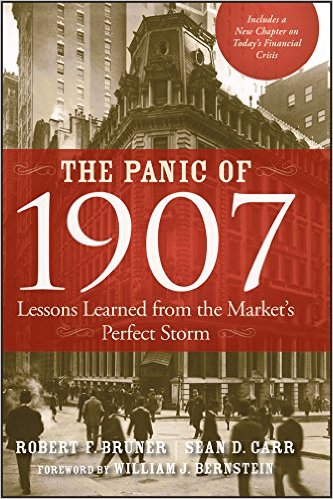The Panic of 1907

Summary
Bruner and Carr offer a magnificent account of the events surrounding the Panic of 1907. Through rich narrative and excellent, accessible descriptions of the financial concepts involved, Bruner and Carr transform the seemingly ancient Panic of 1907 into a vastly relevant piece of financial history. Indeed, the word “panic” is most appropriate for such a period in financial history, as the pre-FDIC, pre-Federal Reserve environment described by Bruner and Carr was extraordinarily exposed to shifts in public sentiment.
For those familiar with the Diamond-Dybvig multiple equilibria model, the phenomena associated with bank-runs shall seem intuitive. The bank run dynamic is a common theme throughout The Panic of 1907, as the financial world was ablaze with a rampant credit crisis self-perpetuated by worried depositors. Much of the narrative Bruner and Carr tell relates to attempts to stave off credit and liquidity crises and the devastating effects such crises have on the entire financial system if left to perpetuate ad infinitum.
Self-reinforcing feedback loops and bank runs
Within the context of fractional-reserve banking, the overpowering self-reinforcing feedback loop of panic-driven activity that is a credit crunch may metastasize into the widespread crippling of an entire economy. In The Panic of 1907, one must recall that there did not yet exist a Federal Reserve Bank (the Fed) or the Federal Deposit Insurance Corporation (FDIC). Hence, the banking system was clearly exposed to deadly shifts in depositor confidence. Interestingly, we may observe a shockingly similar credit crunch episode during the Global Financial Crisis of 2007-2009; the lessons learned from The Panic of 1907 are timeless and immensely valuable.
To briefly explain the dynamic of a bank run and its self-perpetuating nature, consider the following steps that characterize such a scenario: first, often in response to an unstable market or some particularly unsavory market shock, depositors experience a lack of confidence in the safety of their bank accounts; that is, depositors are concerned that they will be able to receive the cash from their bank accounts upon withdrawal. Second, these concerned depositors (quickly) withdraw their funds from the bank at question, as they do not wish to endanger their life savings by leaving them in the accounts of an unstable bank. Note that, within a fractional-reserve banking system, banks hold only a fraction (often around 10%) of all deposits in the form of cash. Hence, as other depositors see their peers withdrawing funds, the scramble for the remaining liquid cash ensues.
In response to increased demands for cash from its depositors, the bank at question seeks to raise as much additional cash as possible in order to meet its reserve requirement and to satisfy depositors’ demands (the bank at question is dealing with a liquidity crisis). The bank may secure loans or sell its remaining assets in a fire-sale–a process known as liquidation. Loans are very tough to come by, as at this point in the process, it is clear to most prospective lenders that the bank at question is in big trouble (now we have the Fed to act as a lender in such a position). Also, liquidation is painful to implement, as the bank at question is often forced to accept undesirable prices for the assets it liquidates. If unable to secure a sizable loan, the bank at question will take (often severe) losses in the liquidation process. Once these losses become larger than the equity of the institution, the bank is insolvent. As the previous process unfolds, depositors panic as they become cognizant of the reality that they may lose the entirety of their bank accounts; throughout such a panic, depositors begin to withdraw their funds at an increasing rate, putting further strain on the bank at question and self-perpetuating the bank’s downfall.
In 1907, runs on banks proliferated throughout the entire financial system–the collapse in depositor credit was indeed an epidemic. Some may believe that such exposure has been eliminated, as FDIC is now in place; this perspective is naive. In fact, during the Global Financial Crisis (particularly in the early spring of 2008), an analogous epidemic began to metastasize–hedge funds, bank-holding companies, and investment banks began to rapidly withdraw their account from one another, thereby creating a run on these institutions (this is how Lehman Brothers failed). While history may not always repeat itself in identical fashion, specific patterns certainly reappear over time. The concepts one stands to learn from reading about periods such as the 1907 financial crisis, are indeed valuable a century after the events featured in Bruner & Carr’s book transpired.
